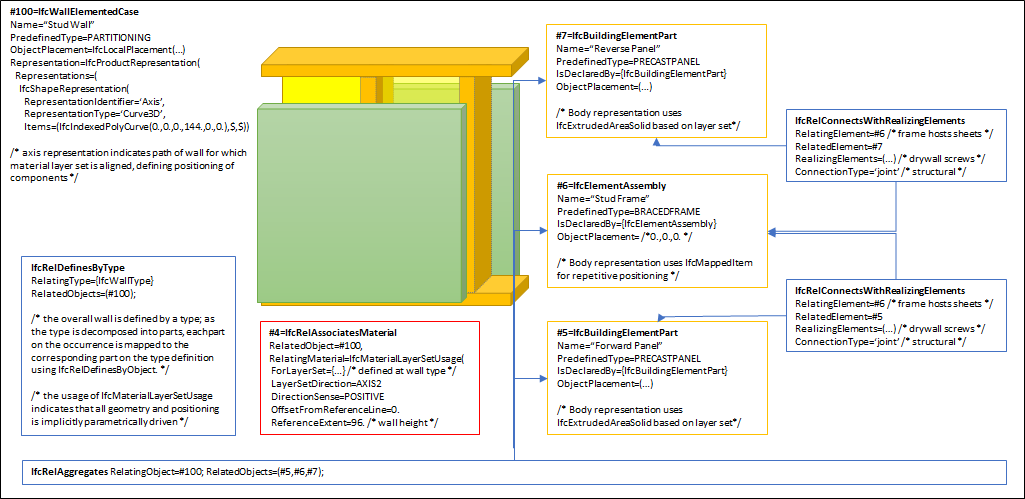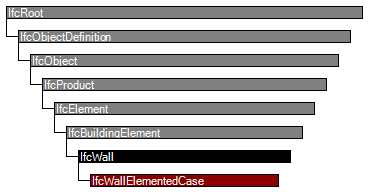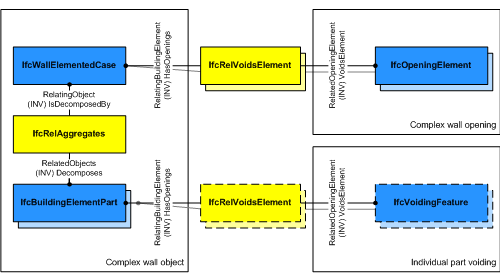Natural language names
 | Wand elementiert |
 | Wall Elemented Case |
 | Mur composite |
Change log
| DEPRECATED | This definition may be imported, but shall not be exported by applications. |
| Item | SPF | XML | Change | Description | IFC2x3 to IFC4 |
|---|---|---|---|---|
| IfcWallElementedCase | ADDED | IFC4x1 Release Candidate 3 | ||
| IfcWallElementedCase | MODIFIED | Status changed to Deprecated. |
Semantic definitions at the entity
Entity definition
The IfcWallElementedCase defines a wall with certain constraints for the provision of its components. The IfcWallElementedCase handles all cases of walls, that are decomposed into parts:
- having components being assigned to the IfcWallElementedCase using the IfcRelAggregates relationship accessible by the inverse relationship IsDecomposedBy.
Parts within the decomposition are usually be of type:
- IfcBuildingElementPart for wall layer, insolation layers and similar
- IfcMember for studs, posts and similar elements,
- IfcElementAssembly for other aggregates, or
- IfcBuildingElementProxy.
EXAMPLE Elemented walls may extend the concepts of standard walls with the following features, as shown in Figure 255, including the IfcRelConnectsWithRealizingElements relationship to define fasteners and accessories.
 |
Figure 255 — Wall elemented case |
HISTORY New entity in IFC4.
Formal Propositions
| Rule | Description |
|---|---|
| HasDecomposition | A valid instance of IfcWallElementedCase has to have parts in a decomposition hierarchy. |
Inherited definitions from supertypes
Entity inheritance

Attribute inheritance
| # | Attribute | Type | Cardinality | Description | G |
|---|---|---|---|---|---|
| IfcRoot | |||||
| 1 | GlobalId | IfcGloballyUniqueId | Assignment of a globally unique identifier within the entire software world. | X | |
| 2 | OwnerHistory | IfcOwnerHistory | ? |
Assignment of the information about the current ownership of that object, including owning actor, application, local identification and information captured about the recent changes of the object,
NOTE only the last modification in stored - either as addition, deletion or modification. IFC4 CHANGE The attribute has been changed to be OPTIONAL. | X |
| 3 | Name | IfcLabel | ? | Optional name for use by the participating software systems or users. For some subtypes of IfcRoot the insertion of the Name attribute may be required. This would be enforced by a where rule. | X |
| 4 | Description | IfcText | ? | Optional description, provided for exchanging informative comments. | X |
| IfcObjectDefinition | |||||
| HasAssignments | IfcRelAssigns @RelatedObjects | S[0:?] | Reference to the relationship objects, that assign (by an association relationship) other subtypes of IfcObject to this object instance. Examples are the association to products, processes, controls, resources or groups. | X | |
| Nests | IfcRelNests @RelatedObjects | S[0:1] | References to the decomposition relationship being a nesting. It determines that this object definition is a part within an ordered whole/part decomposition relationship. An object occurrence or type can only be part of a single decomposition (to allow hierarchical strutures only).
IFC4 CHANGE The inverse attribute datatype has been added and separated from Decomposes defined at IfcObjectDefinition. | X | |
| IsNestedBy | IfcRelNests @RelatingObject | S[0:?] | References to the decomposition relationship being a nesting. It determines that this object definition is the whole within an ordered whole/part decomposition relationship. An object or object type can be nested by several other objects (occurrences or types).
IFC4 CHANGE The inverse attribute datatype has been added and separated from IsDecomposedBy defined at IfcObjectDefinition. | X | |
| HasContext | IfcRelDeclares @RelatedDefinitions | S[0:1] | References to the context providing context information such as project unit or representation context. It should only be asserted for the uppermost non-spatial object.
IFC4 CHANGE The inverse attribute datatype has been added. | X | |
| IsDecomposedBy | IfcRelAggregates @RelatingObject | S[0:?] | References to the decomposition relationship being an aggregation. It determines that this object definition is whole within an unordered whole/part decomposition relationship. An object definitions can be aggregated by several other objects (occurrences or parts).
IFC4 CHANGE The inverse attribute datatype has been changed from the supertype IfcRelDecomposes to subtype IfcRelAggregates. | X | |
| Decomposes | IfcRelAggregates @RelatedObjects | S[0:1] | References to the decomposition relationship being an aggregation. It determines that this object definition is a part within an unordered whole/part decomposition relationship. An object definitions can only be part of a single decomposition (to allow hierarchical strutures only).
IFC4 CHANGE The inverse attribute datatype has been changed from the supertype IfcRelDecomposes to subtype IfcRelAggregates. | X | |
| HasAssociations | IfcRelAssociates @RelatedObjects | S[0:?] | Reference to the relationship objects, that associates external references or other resource definitions to the object.. Examples are the association to library, documentation or classification. | X | |
| IfcObject | |||||
| 5 | ObjectType | IfcLabel | ? |
The type denotes a particular type that indicates the object further. The use has to be established at the level of instantiable subtypes. In particular it holds the user defined type, if the enumeration of the attribute PredefinedType is set to USERDEFINED.
| X |
| IsDeclaredBy | IfcRelDefinesByObject @RelatedObjects | S[0:1] | Link to the relationship object pointing to the declaring object that provides the object definitions for this object occurrence. The declaring object has to be part of an object type decomposition. The associated IfcObject, or its subtypes, contains the specific information (as part of a type, or style, definition), that is common to all reflected instances of the declaring IfcObject, or its subtypes.
IFC4 CHANGE New inverse relationship, change made with upward compatibility for file based exchange. | X | |
| Declares | IfcRelDefinesByObject @RelatingObject | S[0:?] | Link to the relationship object pointing to the reflected object(s) that receives the object definitions. The reflected object has to be part of an object occurrence decomposition. The associated IfcObject, or its subtypes, provides the specific information (as part of a type, or style, definition), that is common to all reflected instances of the declaring IfcObject, or its subtypes.
IFC4 CHANGE New inverse relationship, change made with upward compatibility for file based exchange. | X | |
| IsTypedBy | IfcRelDefinesByType @RelatedObjects | S[0:1] | Set of relationships to the object type that provides the type definitions for this object occurrence. The then associated IfcTypeObject, or its subtypes, contains the specific information (or type, or style), that is common to all instances of IfcObject, or its subtypes, referring to the same type.
IFC4 CHANGE New inverse relationship, the link to IfcRelDefinesByType had previously be included in the inverse relationship IfcRelDefines. Change made with upward compatibility for file based exchange. | X | |
| IsDefinedBy | IfcRelDefinesByProperties @RelatedObjects | S[0:?] | Set of relationships to property set definitions attached to this object. Those statically or dynamically defined properties contain alphanumeric information content that further defines the object.
IFC4 CHANGE The data type has been changed from IfcRelDefines to IfcRelDefinesByProperties with upward compatibility for file based exchange. | X | |
| IfcProduct | |||||
| 6 | ObjectPlacement | IfcObjectPlacement | ? | Placement of the product in space, the placement can either be absolute (relative to the world coordinate system), relative (relative to the object placement of another product), or constraint (e.g. relative to grid axes). It is determined by the various subtypes of IfcObjectPlacement, which includes the axis placement information to determine the transformation for the object coordinate system. | X |
| 7 | Representation | IfcProductRepresentation | ? | Reference to the representations of the product, being either a representation (IfcProductRepresentation) or as a special case a shape representations (IfcProductDefinitionShape). The product definition shape provides for multiple geometric representations of the shape property of the object within the same object coordinate system, defined by the object placement. | X |
| ReferencedBy | IfcRelAssignsToProduct @RelatingProduct | S[0:?] | Reference to the IfcRelAssignsToProduct relationship, by which other products, processes, controls, resources or actors (as subtypes of IfcObjectDefinition) can be related to this product. | X | |
| IfcElement | |||||
| 8 | Tag | IfcIdentifier | ? | The tag (or label) identifier at the particular instance of a product, e.g. the serial number, or the position number. It is the identifier at the occurrence level. | X |
| FillsVoids | IfcRelFillsElement @RelatedBuildingElement | S[0:1] | Reference to the IfcRelFillsElement Relationship that puts the element as a filling into the opening created within another element. | X | |
| ConnectedTo | IfcRelConnectsElements @RelatingElement | S[0:?] | Reference to the element connection relationship. The relationship then refers to the other element to which this element is connected to. | X | |
| IsInterferedByElements | IfcRelInterferesElements @RelatedElement | S[0:?] | Reference to the interference relationship to indicate the element that is interfered. The relationship, if provided, indicates that this element has an interference with one or many other elements.
NOTE There is no indication of precedence between IsInterferedByElements and InterferesElements. IFC4 CHANGE New inverse relationship. | X | |
| InterferesElements | IfcRelInterferesElements @RelatingElement | S[0:?] | Reference to the interference relationship to indicate the element that interferes. The relationship, if provided, indicates that this element has an interference with one or many other elements.
NOTE There is no indication of precedence between IsInterferedByElements and InterferesElements. IFC4 CHANGE New inverse relationship. | X | |
| HasProjections | IfcRelProjectsElement @RelatingElement | S[0:?] | Projection relationship that adds a feature (using a Boolean union) to the IfcBuildingElement. | X | |
| ReferencedInStructures | IfcRelReferencedInSpatialStructure @RelatedElements | S[0:?] | Reference relationship to the spatial structure element, to which the element is additionally associated. This relationship may not be hierarchical, an element may be referenced by zero, one or many spatial structure elements.
IFC2x3 CHANGE The inverse attribute has been added with upward compatibility for file based exchange. | X | |
| HasOpenings | IfcRelVoidsElement @RelatingBuildingElement | S[0:?] | Reference to the IfcRelVoidsElement relationship that creates an opening in an element. An element can incorporate zero-to-many openings. For each opening, that voids the element, a new relationship IfcRelVoidsElement is generated. | X | |
| IsConnectionRealization | IfcRelConnectsWithRealizingElements @RealizingElements | S[0:?] | Reference to the connection relationship with realizing element. The relationship, if provided, assigns this element as the realizing element to the connection, which provides the physical manifestation of the connection relationship. | X | |
| ProvidesBoundaries | IfcRelSpaceBoundary @RelatedBuildingElement | S[0:?] | Reference to space boundaries by virtue of the objectified relationship IfcRelSpaceBoundary. It defines the concept of an element bounding spaces. | X | |
| ConnectedFrom | IfcRelConnectsElements @RelatedElement | S[0:?] | Reference to the element connection relationship. The relationship then refers to the other element that is connected to this element. | X | |
| ContainedInStructure | IfcRelContainedInSpatialStructure @RelatedElements | S[0:1] | Containment relationship to the spatial structure element, to which the element is primarily associated. This containment relationship has to be hierachical, i.e. an element may only be assigned directly to zero or one spatial structure. | X | |
| HasCoverings | IfcRelCoversBldgElements @RelatingBuildingElement | S[0:?] | Reference to IfcCovering by virtue of the objectified relationship IfcRelCoversBldgElement. It defines the concept of an element having coverings associated. | X | |
| IfcBuildingElement | |||||
| IfcWall | |||||
| 9 | PredefinedType | IfcWallTypeEnum | ? |
Predefined generic type for a wall that is specified in an enumeration. There may be a property set given specifically for the predefined types.
NOTE The PredefinedType shall only be used, if no IfcWallType is assigned, providing its own IfcWallType.PredefinedType. IFC4 CHANGE The attribute has been added at the end of the entity definition. | X |
| IfcWallElementedCase | |||||
Definitions applying to General Usage
Concept usage
Product Local Placement
The Product Local Placement concept template applies to this entity as shown in Table 189.
| ||||||
Table 189 — IfcWallElementedCase Product Local Placement |
The use of local placement is defined at the supertype IfcWall. The local placement of the IfcWallElementedCase defines the parent coordinate systems for the parts within the decomposition. All parts shall be positioned relative to the IfcWallElementedCase.
Surface Geometry
The Surface Geometry concept applies to this entity.
The 'Surface Geometry' shape representation can be used to define a surfacic model of the building (e.g. for analytical purposes, or for reduced Level of Detail representation). It could suppress the geometric details of the parts in the decomposition.
NOTE It is invalid to exchange a 'Body' shape representation of an IfcWallElementedCase. The body geometry is defined by the parts within the decomposition.
Element Decomposition
The Element Decomposition concept template applies to this entity as shown in Table 190.
| |||||||||
Table 190 — IfcWallElementedCase Element Decomposition |
An elemented wall is decomposed into parts for particular components such as framing and panels on each side. There must be an object corresponding to each type of part, however there may be single object instance indicating multiple placements (via mapping geometry) for each part, or multiple instances corresponding to each placement. For minimizing file size, it is recommended to use a single object with multiple placement unless there are specific connectivity relationships indicated (e.g. a junction box connected to a specific stud).
Element Voiding
The Element Voiding concept template applies to this entity as shown in Table 191.
| ||||||||
Table 191 — IfcWallElementedCase Element Voiding |
As shown in Figure 256, openings within the composite wall are directly assigned to IfcWallElementedCase using IfcRelVoidsElement pointing to IfcOpeningElement and apply to all aggregated parts. If individual parts have cutting and other voiding features, then the decomposed parts have a separate voiding relationship IfcRelVoidsElement pointing to IfcVoidingFeature.
 |
Figure 256 — Wall elemented voiding |
mvdXML Specification
<?xml version="1.0"?>
<ConceptRoot xmlns:xsi="http://www.w3.org/2001/XMLSchema-instance" xmlns:xsd="http://www.w3.org/2001/XMLSchema" uuid="7234582b-3e33-44fe-ae26-21f8e24bfc68" name="IfcWallElementedCase" status="sample" applicableRootEntity="IfcWallElementedCase">
<Applicability uuid="00000000-0000-0000-0000-000000000000" status="sample">
<Template ref="e2a4e03d-691e-416c-b71a-4e7133abd42d" />
<TemplateRules operator="and" />
</Applicability>
<Concepts>
<Concept uuid="982edf62-3924-43e5-99f0-e13c10669a25" name="Product Local Placement" status="sample" override="false">
<Template ref="cbe85b5f-7912-4a43-8bb7-1e63bf40b26d" />
</Concept>
<Concept uuid="f9ea8de5-6955-47ae-a9dc-d04f10964ece" name="Surface Geometry" status="sample" override="false">
<Template ref="2e99de70-fb73-478f-9bca-4fedfdeb4ea5" />
</Concept>
<Concept uuid="690cfae5-8fb2-4c83-800a-9a793f0c0c8e" name="Element Decomposition" status="sample" override="false">
<Template ref="8a27c15a-c4ea-4ca9-8cce-7fbba1c9bce0" />
<TemplateRules operator="and">
<TemplateRule Description="Frame containing studs, tracks, and possibly insulation" Parameters="RelatedObjects[Type]='IfcElementAssembly'" />
<TemplateRule Description="Panels on each side such as gypsum (drywall) or cement board (tile backing) with fasteners" Parameters="RelatedObjects[Type]='IfcBuildingElementPart'" />
</TemplateRules>
</Concept>
<Concept uuid="79db20d2-4de5-4dd3-9394-8804b48a6ff2" name="Element Voiding" status="sample" override="false">
<Template ref="b9005e79-b5c5-4c0b-9d86-046c21ad420d" />
</Concept>
</Concepts>
</ConceptRoot>
Concept inheritance
Examples
Formal representations
XML Specification
<xs:element name="IfcWallElementedCase" type="ifc:IfcWallElementedCase" substitutionGroup="ifc:IfcWall" nillable="true"/>
<xs:complexType name="IfcWallElementedCase">
<xs:complexContent>
<xs:extension base="ifc:IfcWall"/>
</xs:complexContent>
</xs:complexType>
EXPRESS Specification
ENTITY IfcWallElementedCase
SUBTYPE OF (IfcWall);
WHERE
HasDecomposition : HIINDEX(SELF\IfcObjectDefinition.IsDecomposedBy) > 0;
END_ENTITY;

 Instance diagram
Instance diagram Link to this page
Link to this page